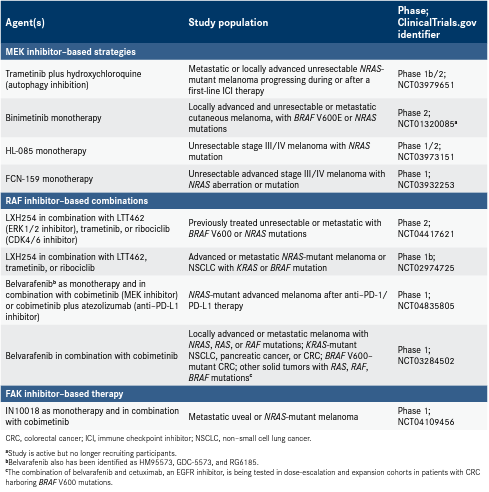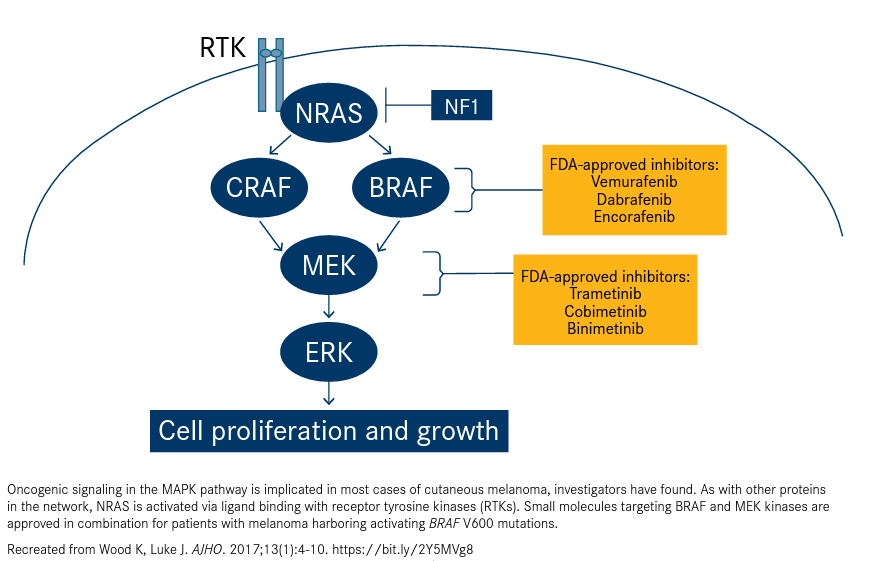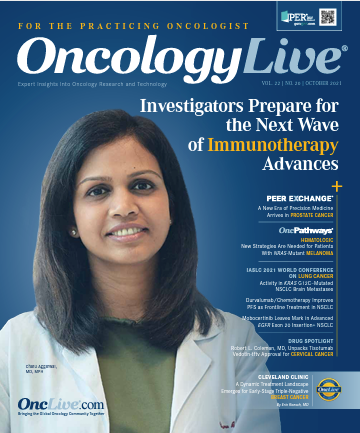Publication
Article
New Strategies Are Needed for Patients With NRAS-Mutant Melanoma
Author(s):
Although there has been dramatic progress in the treatment landscape for metastatic melanoma over the past decade, many patients whose tumors harbor NRAS mutations have not shared in the improved outcomes.
Caroline Robert, MD, PhD

Although there has been dramatic progress in the treatment landscape for metastatic melanoma over the past decade, many patients whose tumors harbor NRAS mutations have not shared in the improved outcomes. There are no therapies designed to directly target this alteration, and some studies show a limited benefit from immunotherapy.1,2
Activating NRAS mutations, which are detected in approximately 20% of cutaneous melanoma cases, are among the most frequently observed driver mutations in patients with the malignancy.1,3 Investigators are exploring several novel strategies to address the needs of this population, including the development of agents that target different nodes of the MAPK cell-signaling network that includes NRAS alterations and is activated in nearly all cases of cutaneous melanoma.3,4
Genentech is testing belvarafenib, a pan-RAF kinase inhibitor, in patients with NRAS-mutant advanced melanoma.5 Novartis is evaluating LXH254, a RAF inhibitor that is highly selective for BRAF and CRAF, in patients with NRAS-mutant melanoma.6 Early-phase studies employing combinations that pair approved MEK inhibitors with other targeted agents also are under way (Table3,5,6).
Table. Ongoing Clinical Studies Targeting NRAS-Mutant Melanoma3,5,6

Prevalence of NRAS Mutations
In the 1980s, NRAS became the first oncogene described in melanoma after investigators analyzed DNA from melanoma cell lines.7,8 NRAS is a member of the RAS superfamily of guanosine triphosphate–binding proteins, which includes KRAS and HRAS. In melanoma, activated NRAS proteins leverage receptor tyrosine kinases to stimulate intracellular signaling in the MAPK pathway, which promotes cell proliferation and growth (Figure4).4,7
Figure. MAPK Signaling Network Drives Melanoma4

NRAS mutations are the most frequently observed of the RAS isoforms in cutaneous melanoma. Whereas KRAS and HRAS mutations are detected in 2% and 1% of cutaneous melanomas, respectively, NRAS mutations are found in 20%, most commonly in the exon 1 (G12 and G13 substitutions) and exon 2 link (Q61 substitution).1,3
NRAS mutations, however, have been overshadowed by BRAF alterations. Nearly 40% of patients with melanoma have tumors harboring a BRAF mutation, with BRAF V600 aberrations as the most prevalent subtype, according to a whole-genome sequencing analysis by the Australian Melanoma Genome Project. That makes BRAF the most frequently mutated gene, followed by NRAS.1,9
Investigators have learned that patients with NRAS-mutated melanomas are generally older when they receive a diagnosis (> 55 years) with thicker tumors that are more likely to be located on the extremities and greater rates of mitosis than patients with BRAF-mutated or BRAF wild-type tumors. Although activating mutations of BRAF and NRAS typically exist independent of each other, both mutations are associated with aggressive melanoma and shorter survival compared with tumors that are wild-type for both aberrations.7
Despite a growing knowledge base about NRAS mutations, these alterations have proved more difficult to target than BRAF mutations. The population of patients with NRAS mutations is among those with melanoma in need of new therapeutic approaches, even amid the remarkable gains that have been made against the malignancy, experts say.
A Decade of Progress
Since 2010, the melanoma field has witnessed a “golden decade,” according to Caroline Robert, MD, PhD, head of the dermatology unit at Gustave Roussy and codirector of the melanoma research unit at Paris-Sud University in Villejuif, France. Robert, a 2018 Giants of Cancer Care® award winner in the melanoma category, reviewed progress in the treatment paradigm during an industry-sponsored symposium at the European Society for Medical Oncology (ESMO) 2021 Congress.2
At the start of 2010, no systemic therapy had been shown to significantly extend survival in patients with metastatic melanoma, Robert said. The standard of care was chemotherapy with dacarbazine, which demonstrated a median overall survival (OS) of 231 days or 7.6 months, she noted. Today, the paradigm includes options for the adjuvant setting as well as immune checkpoint inhibitor (ICI) and targeted therapy for metastatic disease.2
The progress that has been made is evident in recent long-term analyses of pivotal clinical trial data. The median OS ranged from 22.5 months to 33.6 months for patients with advanced melanoma with BRAF V600 mutations treated with combination regimens of BRAF and MEK inhibitors, according to 5-year trial data. For patients with advanced melanoma who receive ICI therapy, the median OS reached 38.7 months with single-agent pembrolizumab (Keytruda), a PD-1 inhibitor, in a 5-year follow-up analysis of pooled data from the phase 3 KEYNOTE-006 trial (NCT01866319).2
Meanwhile, patients with previously untreated advanced melanoma who received a combination of nivolumab (Opdivo), a PD-1 inhibitor, plus ipilimumab (Yervoy), a CTLA-4 inhibitor, achieved a median OS of 72.1 months in the phase 3 CheckMate 067 trial (NCT01844505), with 50% of the patients surviving 5 years, according to 6.5-year follow-up data.2 That outcome is nearly 10 times longer than the median OS was with dacarbazine, Robert noted. “This is huge, a huge improvement,” she said.
Nevertheless, Robert said, “it also means there are 50% of patients who have died of their melanoma in these 5 years and now it is for these patients that we have to work and understand how to optimize our treatments.”
Robert said there are several groups of patients not achieving long-term survival in the evolving melanoma landscape. These include patients who develop primary or acquired resistance to therapy, are unable to tolerate or receive current therapies, have high lactate dehydrogenase levels or a high disease burden, have brain and/or liver metastases, and Robert said there are several groups of patients not achieving long-term survival in the evolving melanoma landscape. These include patients who develop primary or acquired resistance to therapy, are unable to tolerate or receive current therapies, have high lactate dehydrogenase levels or a high disease burden, have brain and/or liver metastases, and have other melanoma subtypes such as mucosal melanoma.
Need for More Options
Although targeted therapy and ICI therapy are twin pillars of the melanoma treatment paradigm, the National Comprehensive Cancer Network (NCCN) guidelines panel considers recommended ICI options as appropriate first-line systemic therapy for patients with distant metastatic or unresectable melanoma regardless of BRAF mutation status. Preferred ICI regimens are single-agent nivolumab or pembrolizumab or the combination of ipilimumab plus nivolumab.10
For patients with activating BRAF V600 mutations, 3 regimens combining BRAF and MEK inhibitors also are category 1 choices: dabrafenib (Tafinlar) plus trametinib (Mekinist), vemurafenib (Zelboraf) plus cobimetinib (Cotellic), and encorafenib (Braftovi) plus binimetinib (Mektovi).
However, there is evidence that ICI therapy is not similarly effective across molecular subtypes. Patients with BRAF V600 wild-type tumors represent a significant population with unmet needs, including those who receive ICI therapy in the front line, Matteo C. Carlino, MBBS, FRACP, PhD, said during a presentation at the 2021 American Society of Clinical Oncology Annual Meeting.1 Carlino is a medical oncologist at Westmead Hospital, Blacktown Hospital, and the Melanoma Institute Australia and a clinical associate professor at Sydney Medical School, University of Sydney.
Matteo C. Carlino, MBBS, FRACP, PhD

In the broad category of patients without BRAF mutations, ICI therapy outcomes are less beneficial than for those with BRAF V600–mutated malignancy, Carlino said. In CheckMate 067, outcomes were worse for patients without BRAF mutations. At 5 years, the OS rates for patients with BRAF-mutated compared with BRAF wild-type tumors were 60% vs 48%, respectively, for those who received the combination of nivolumab plus ipilimumab, 46% vs 43% for participants in the single-agent nivolumab arm, and 30% vs 25% in the ipilimumab-monotherapy group. Progression-free survival (PFS) rates and median OS also were higher for patients with BRAF mutations compared with BRAF wild-type tumors.11
“In the BRAF wild-type subgroup, approximately two-thirds of patients have progressed by 5 years and over 50% of patients have died in that time frame,” Carlino said. “As such there’s a significant patient population of BRAF wild-type patients who require further treatment beyond an anti–PD-1 agent alone or in combination with ipilimumab.”
Specifically for NRAS mutations, clinical trial findings are more difficult to interpret. “There [are] conflicting data regarding the prognostic impact of NRAS mutations, with some studies showing no impact, other studies saying [patients with] NRAS mutations have a poorer survival, and there [are] some data to suggest there is a higher likelihood of response to immune checkpoint inhibition with NRAS mutations,” Carlino said.
Findings from the pivotal trials that led to FDA approval of ICI therapies did not specify outcomes for patients with NRAS mutations, and much of what is known about the impact for this population comes from retrospective analyses, according to melanoma specialists from Vall d’Hebron Institute of Oncology in Barcelona, Spain. In findings from 3 ICI studies, patients with NRAS mutations had a lower rate of median OS in 1 study than participants with NRAS wild-type tumors (21 vs 33 months; P = .034), a higher rate in another (19.5 vs 15.2 months; P = .51), and no significant difference in the third study (32 vs 27 months; P not specified).3
Mek Inhibitors Tested
Investigators searching for new strategies for patients in underserved subgroups are focusing on the MAPK pathway, as 98% of cases in the Australian genomic study had at least 1 mutation in the network, Carlino noted. For NRAS-mutated tumors, some progress has been made with inhibiting MEK, another node in the pathway. However, MEK inhibition has shown limited efficacy as monotherapy, and combinations pairing these agents with CDK4/6 inhibitors, pan-RAF inhibitors, or PI3K inhibitors are being studied.1,3
Binimetinib
One MEK inhibitor that has shown positive results as a single agent is binimetinib, which demonstrated an improvement in PFS compared with dacarbazine for patients with NRAS-mutated melanoma. Binimetinib has been incorporated into the NCCN guidelines as a category 2B option for patients with this alteration who have progressed after prior ICI therapy.10
In the phase 3 NEMO trial (NCT01763164), 402 patients with unresectable stage IIIC or stage IV NRAS-mutated melanoma who were either previously untreated or had progressed after prior immunotherapy were randomized 2:1 to receive either binimetinib at 45 mg orally twice daily or dacarbazine at 1000 mg/m2 intravenously every 3 weeks.12
After a median follow-up of 1.7 months, the median PFS was 2.8 months (95% CI, 2.8-3.6) for those treated with binimetinib (n = 269) compared with 1.5 months (95% CI, 1.5-1.7) for participants given dacarbazine (n = 133), which translated into a statistically significant advantage for the targeted agent (HR, 0.62; 95% CI, 0.47-0.80; 1-sided P < .001). The overall response rate (ORR) was 15% (95% CI, 11%-20%) with binimetinib compared with 7% (95% CI, 3%-13%) with dacarbazine.
The benefit with binimetinib was more pronounced for participants who received previous immunotherapy. In this group, the median PFS with binimetinib was 5.5 months (95% CI, 2.8-7.6) compared with 1.6 months (95% CI, 1.5-2.8) for those who had dacarbazine. Moreover, the confirmed ORR was 16% among 57 patients in the binimetinib group compared with 4% among 28 patients in the dacarbazine arm.
Binimetinib also demonstrated an advantage in OS, a secondary end point of the trial, but not a statistically significant improvement. After a median follow-up of 9.2 months, the median OS in the binimetinib group was 11.0 months (95% CI, 8.9-13.6) compared with 10.1 months (95% CI, 7.0-16.5) in the dacarbazine cohort (HR, 1.00; 95% CI, 0.75-1.33; 1-sided P = .50).
NEMO, which was launched in 2013, was the largest study conducted in patients with NRAS-mutated melanoma at the time the f indings were published in Lancet Oncology in 2017, investigators said. However, Carlino said the study was conceived before PD-1 inhibitors were widely available. “There was a suggestion of a greater activity in patients with prior immunotherapy, but really this needs to be interpreted cautiously given the minority of patients who had prior immunotherapy,” Carlino said.
Investigators also tested binimetinib in combination with ribociclib (Kisqali), a CDK4/6 inhibitor that is FDA approved in combination with endocrine therapy to treat patients with hormone receptor–positive, HER2-negative advanced or metastatic breast cancer.13 In a dose-expansion portion of a phase 1/2 study (NCT01781572), the combination resulted in an ORR of 19.5%, all partial responses, and a 51.2% stable disease rate in 41 patients with advanced or metastatic NRAS-mutant melanoma. The PFS was 3.7 months (95% CI, 3.5-5.6).14
RAF Inhibitors
Belvarafenib
One emerging strategy for attacking NRASmutated melanoma is targeting RAF, one of the kinases in the MAPK pathway, in combination with other therapies. Genentech is collaborating with Hanmi Pharmaceutical Co Ltd, a company based in Seoul, South Korea, to develop belvarafenib, a pan-RAF inhibitor also known as HM95573, GDC-5573, and RG6185.15
Belvarafenib monotherapy generated an unconfirmed best overall response in 4 of 9 patients (44.4%) patients with NRAS-mutant melanoma treated during a multicohort phase 1 dose-escalation study (NCT02405065) in advanced solid tumors. The median PFS among these patients was 24.9 weeks (95% CI, 4.8-84.0) with a median duration of response of 17.8 weeks (95% CI, 3.3-37.3). In a dose-expansion study (NCT03118817), 2 of 10 patients (20.0%) with NRAS-mutant melanoma reached a best overall response.5
In ongoing research, the combination of belvarafenib plus cobimetinib, a MEK inhibitor, is being tested in patients with NRAS-mutated melanoma as part of an expansion cohort of a phase 1 study (NCT03284502) in locally advanced or metastatic solid tumors that have not responded to prior therapies or do not have standard treatment options. Other cohorts of this study focus on patients with KRAS, RAS, RAF, or BRAF V600 mutations.
In another phase 1 study (NCT04835805), belvarafenib is being evaluated as monotherapy and in combination with either cobimetinib or cobimetinib plus atezolizumab (Tecentriq), a PD-L1 inhibitor, in patients with NRAS-mutant advanced melanoma who have received prior anti–PD-1/ PD-L1 ICI therapy.
LXH254
Results of preclinical studies in mouse models show that LXH254 strongly inhibits 2 members of the RAF family, BRAF and CRAF, but has limited activity against a third member, ARAF. Investigators theorize that LXH254’s sparing of ARAF may improve tolerability in normal tissues and make the agent a good candidate for combination therapy targeting downstream effectors, including MEK, ERK, or CDK4/6.6
In a first-in-human phase 1 study (NCT02607813), LXH254 monotherapy was tested across 9 dosing levels in 81 patients with advanced solid tumors harboring at least 1 MAPK pathway alteration. Overall, 2 patients with KRAS- and BRAF-mutant disease achieved confirmed partial responses and 34.6% of participants reached stable disease. The study included 8 participants with skin melanoma but results for this cohort were not reported separately.16
LXH254 is being evaluated in combination with LTT462, an ERK1/2 inhibitor; trametinib; or ribociclib in patients with previously treated unresectable or metastatic melanoma harboring BRAF V600 or NRAS mutations in a phase 2 study (NCT04417621). Investigators aim to recruit 320 participants.
References
- Carlino MS. NRAS and other emerging targetable mutations in melanoma. Presented at: 2021 American Society of Clinical Oncology Annual Meeting; June 4-8, 2021; virtual. https://bit.ly/3F3Ykyc
- Robert C, Long G, Mohr P. Shaping tomorrow today: what does the future hold for melanoma? Presented at: European Society for Medical Oncology 2021 Industry Satellite Symposium; September 21, 2021; virtual. https://bit.ly/3ARDEaa
- Garcia-Alvarez A, Ortiz C, Muñoz-Couselo E. Current perspectives and novel strategies of NRAS-mutant melanoma. Onco Targets Ther. 2021;14:3709-3719. doi:10.2147/OTT.S278095
- Wood K, Luke J. The biology and therapeutic approach to BRAF mutant cutaneous melanoma. AJHO. 2017;13(1):4-10. https://bit.ly/2Y5MVg8
- Kim TW, Lee J, Shin SJ, et al. Belvarafenib, a novel pan-RAF inhibitor, in solid tumor patients harboring BRAF, KRAS, or NRAS mutations: phase I study. J Clin Oncol. 2019;37(suppl 15):3000. doi:10.1200/JCO.2019.37.15_suppl.3000
- Monaco KA, Delach S, Yuan J, et al. LXH254, a potent and selective ARAF-sparing inhibitor of BRAF and CRAF for the treatment of MAPK-driven tumors. Clin Cancer Res. 2021;27(7):2061-2073. doi:10.1158/1078-0432.CCR-20-2563
- Normanno N. NRAS in melanoma: ESMO biomarker factsheet. OncologyPro. Updated August 1, 2015. Accessed September 28, 2021. https://bit.ly/3mfCgbe
- Albino AP, Le Strange R, Oliff AI, Furth ME, Old LJ. Transforming ras genes from human melanoma: a manifestation of tumour heterogeneity? Nature. 1984;308(5954):69-72. doi:10.1038/308069a0
- Hayward NK, Wilmott JS, Waddell N, et al. Whole-genome landscapes of major melanoma subtypes. Nature. 2017;545(7653):175-180. doi:10.1038/nature22071
- NCCN. Clinical Practice Guidelines in Oncology. Melanoma: cutaneous, version 2.2021. Accessed September 28, 2021. https://bit.ly/2Y5MRha
- Larkin J, Chiarion-Sileni V, Gonzalez R, et al. Five-year survival with combined nivolumab and ipilimumab in advanced melanoma. N Engl J Med. 2019;381(16):1535-1546. doi:10.1056/NEJMoa1910836
- Dummer R, Schadendorf D, Ascierto PA, et al. Binimetinib versus dacarbazine in patients with advanced NRAS-mutant melanoma (NEMO): a multicentre, open-label, randomised, phase 3 trial. Lancet Oncol. 2017;18(4):435-445. doi:10.1016/S1470-2045(17)30180-8
- Kisqali. Prescribing information. Novartis Pharmaceuticals Corporation; 2021. Accessed September 28, 2021. https://bit.ly/3kR2jpQ
- A phase Ib/II study of LEE011 in combination with MEK162 in patients with NRAS mutant melanoma. ClinicalTrials.gov. Updated December 7, 2020. Accessed September 28, 2021. https://clinicaltrials.gov/ct2/show/results/NCT01781572?view=results
- Hanmi Pharmaceutical enters into an exclusive license agreement with Genentech for a novel oral RAF inhibitor. News release. Hanmi Pharmaceutical Co Ltd. September 29, 2016. Accessed September 29, 2021. https://bwnews.pr/3AVIUcJ
- Janku F, Iyer G, Spreafico A, et al. A phase I study of LXH254 in patients (pts) with advanced solid tumors harboring MAPK pathway alterations. J Clin Oncol. 2018;36(suppl 15):2586. doi:10.1200/JCO.2018.36.15_suppl.2586










